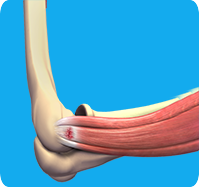- Anatomy
- Conditions
- Procedures

Elbow Impingement
Elbow impingement is a medical condition characterized by compression and injury of soft tissue structures, such as cartilage, at the back of the elbow or within the elbow joint. It is a condition caused by repetitive forced extensions and overuse of the elbow.

Elbow Ligament Injuries
Elbow ligament injuries are injuries to the tough elastic tissues that connect the bones of the elbow joint to each other. These ligaments stabilize the elbow while allowing an appropriate joint range of motion to occur. An acute or chronic injury to the elbow ligament can result in joint laxity and loss of elbow function.

Elbow Trauma
The elbow is a complex joint of the upper limb, formed by the articulation of the long bone of the upper arm or humerus, and the two bones of the forearm - the radius and ulna. It is one of the important joints of the upper limb and is involved in basic movements such as bending and extending the arm and rotating the forearm.

Elbow Arthritis
Elbow arthritis is an inflammatory condition that causes pain, swelling, stiffness, and interference with the use of the arm.Arthritis can affect all ages but is most commonly seen in people aged over 40 years. The most common cause is wear and tear. Apart from that, traumatic injuries, fractures, and dislocations make you more susceptible to arthritis.

Bicep Tendon Tear at the Elbow
A biceps tendon tear can be caused by an injury where your elbow is forced against resistance or while lifting heavy objects. Other problems such as tendonitis are more likely to weaken or tear the biceps tendon. Additional risk factors such as advancing age, smoking and use of corticosteroids can also result in a tendon tear.

Elbow Dislocation
The arm in the human body is made up of three bones that join to form a hinge joint called the elbow. The upper arm bone or humerus connects from the shoulder to the elbow to form the top of the hinge joint. The lower arm or forearm consists of two bones, the radius, and the ulna. These bones connect the wrist to the elbow forming the bottom portion of the hinge joint.

Tennis Elbow
Tennis elbow is a common name for the elbow condition lateral epicondylitis. It is an overuse injury that causes inflammation and microtears of the tendons that attach to the lateral epicondyle.Tennis elbow is a painful condition occurring from repeated muscle contractions at the forearm.

Golfer's Elbow
Golfer’s elbow, also called medial epicondylitis, is a painful condition occurring from repeated muscle contractions in the forearm that leads to inflammation and microtears in the tendons that attach to the medial epicondyle.Golfer’s elbow and tennis elbow are similar, except that golfer’s elbow occurs on the inside of the elbow and tennis elbow occurs on the outside of the elbow.

Elbow Pain
The elbow is a hinge joint made up of 3 bones – the humerus, radius, and ulna. The bones are held together by ligaments to provide stability to the joint. Muscles and tendons move the bones around each other and help in performing various movements. Nerves pass through the joint.

Radial Head Fractures of the Elbow
Radial head fractures are very common and occur in almost 20% of acute elbow injuries. Elbow dislocations are generally associated with radial head fractures. Radial head fractures are more common in women than in men and occur more frequently in the age group of 30 to 40 years.

Elbow Fractures
Elbow fractures may occur from trauma, resulting from various reasons: a fall on an outstretched arm, a direct blow to the elbow or an abnormal twist to the joint beyond its functional limit.To diagnose an elbow fracture, your doctor will review your history, perform a thorough physical examination and order X-rays of the joint.

Distal Biceps Injuries
The biceps is a large muscle present in front of the upper arm, extending from the shoulder joint to the elbow. The lower end of the biceps muscle called the distal biceps forms a tendon which attaches to the upper part of the radius in the elbow. Injuries to this tendon are called distal biceps injuries.

Elbow Instability
Elbow instability is a condition in which the elbow joint occasionally slides out of alignment due to the unstable state of the joint.The elbow joint is made up of three bones: the humerus (upper arm bone), and the radius and ulna (the forearm bones). It consists of a hinge joint that permits flexion and extension of the arm, and a ball-and-socket joint that enables rotation of the wrist.

Triceps Tendon Rupture
Triceps tendonitis is inflammation of the triceps tendon, the tissue that connects the triceps muscle on the back of the upper arm to the back of the elbow joint, allowing you to straighten your arm back after you have bent it.

Cubital Tunnel Syndrome
When the elbow is bent, the ulnar nerve can stretch and catch on the bony bump. When the ulnar nerve is compressed or entrapped, the nerve can tear and become inflamed, leading to cubital tunnel syndrome.
